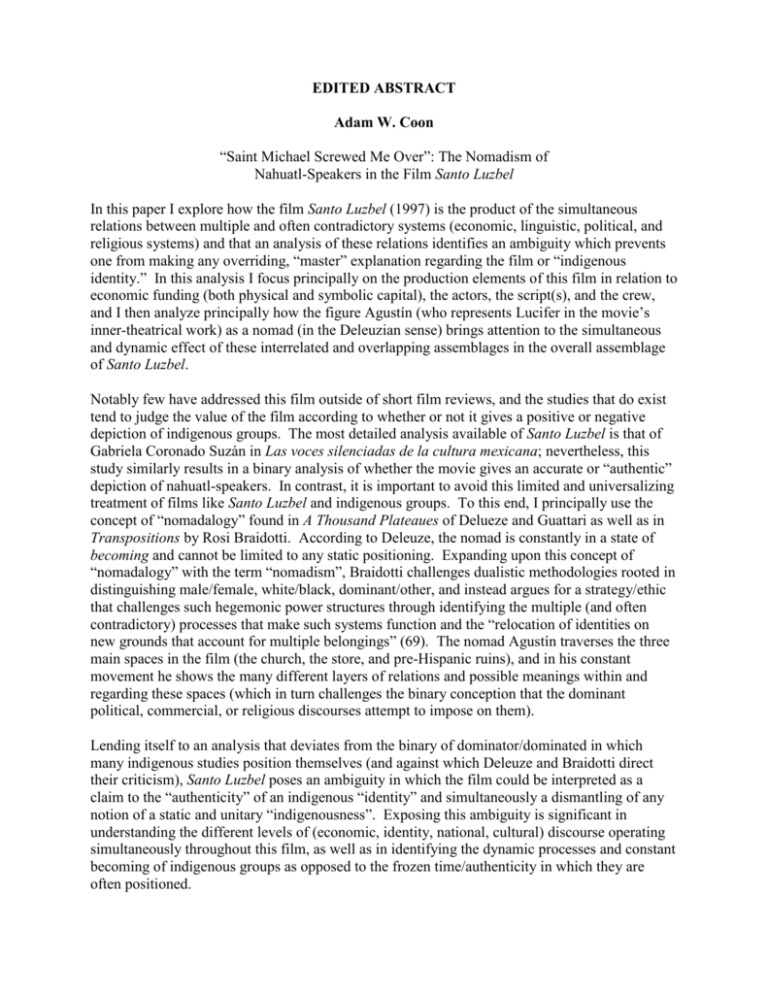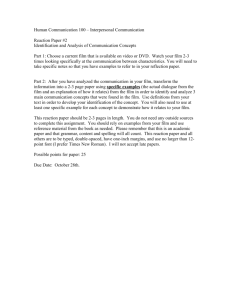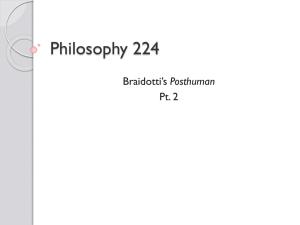EDITED ABSTRACT
advertisement

EDITED ABSTRACT Adam W. Coon “Saint Michael Screwed Me Over”: The Nomadism of Nahuatl-Speakers in the Film Santo Luzbel In this paper I explore how the film Santo Luzbel (1997) is the product of the simultaneous relations between multiple and often contradictory systems (economic, linguistic, political, and religious systems) and that an analysis of these relations identifies an ambiguity which prevents one from making any overriding, “master” explanation regarding the film or “indigenous identity.” In this analysis I focus principally on the production elements of this film in relation to economic funding (both physical and symbolic capital), the actors, the script(s), and the crew, and I then analyze principally how the figure Agustín (who represents Lucifer in the movie’s inner-theatrical work) as a nomad (in the Deleuzian sense) brings attention to the simultaneous and dynamic effect of these interrelated and overlapping assemblages in the overall assemblage of Santo Luzbel. Notably few have addressed this film outside of short film reviews, and the studies that do exist tend to judge the value of the film according to whether or not it gives a positive or negative depiction of indigenous groups. The most detailed analysis available of Santo Luzbel is that of Gabriela Coronado Suzán in Las voces silenciadas de la cultura mexicana; nevertheless, this study similarly results in a binary analysis of whether the movie gives an accurate or “authentic” depiction of nahuatl-speakers. In contrast, it is important to avoid this limited and universalizing treatment of films like Santo Luzbel and indigenous groups. To this end, I principally use the concept of “nomadalogy” found in A Thousand Plateaues of Delueze and Guattari as well as in Transpositions by Rosi Braidotti. According to Deleuze, the nomad is constantly in a state of becoming and cannot be limited to any static positioning. Expanding upon this concept of “nomadalogy” with the term “nomadism”, Braidotti challenges dualistic methodologies rooted in distinguishing male/female, white/black, dominant/other, and instead argues for a strategy/ethic that challenges such hegemonic power structures through identifying the multiple (and often contradictory) processes that make such systems function and the “relocation of identities on new grounds that account for multiple belongings” (69). The nomad Agustín traverses the three main spaces in the film (the church, the store, and pre-Hispanic ruins), and in his constant movement he shows the many different layers of relations and possible meanings within and regarding these spaces (which in turn challenges the binary conception that the dominant political, commercial, or religious discourses attempt to impose on them). Lending itself to an analysis that deviates from the binary of dominator/dominated in which many indigenous studies position themselves (and against which Deleuze and Braidotti direct their criticism), Santo Luzbel poses an ambiguity in which the film could be interpreted as a claim to the “authenticity” of an indigenous “identity” and simultaneously a dismantling of any notion of a static and unitary “indigenousness”. Exposing this ambiguity is significant in understanding the different levels of (economic, identity, national, cultural) discourse operating simultaneously throughout this film, as well as in identifying the dynamic processes and constant becoming of indigenous groups as opposed to the frozen time/authenticity in which they are often positioned.







